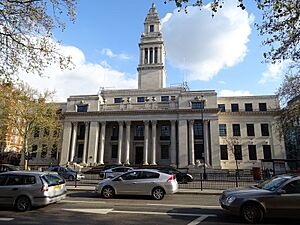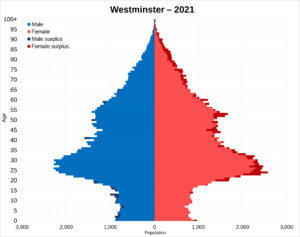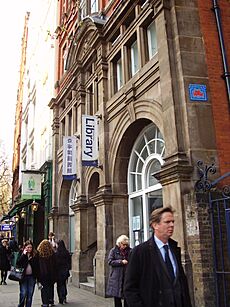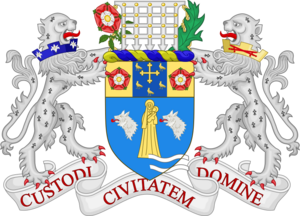City of Westminster facts for kids
Quick facts for kids
City of Westminster
|
|||
|---|---|---|---|
|
London borough and city
|
|||

Trafalgar Square, an open plaza in the city
|
|||
|
|||
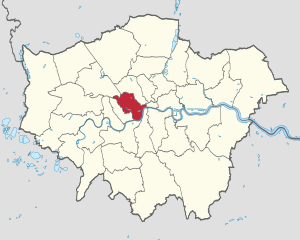
Westminster shown within Greater London
|
|||
| Sovereign state | United Kingdom | ||
| Country | England | ||
| Region | London | ||
| Ceremonial county | Greater London | ||
| Created | 1 April 1965 | ||
| Admin HQ | City Hall, Victoria Street | ||
| Government | |||
| • Type | London borough council | ||
| • Body | Westminster City Council | ||
| Area | |||
| • Total | 8.29 sq mi (21.48 km2) | ||
| Area rank | 318th (of 326) | ||
| Population
(2020)
|
|||
| • Total | 261,317 | ||
| • Rank | 63rd (of 326) | ||
| • Density | 31,509/sq mi (12,165.6/km2) | ||
| Time zone | UTC (GMT) | ||
| • Summer (DST) | UTC+1 (BST) | ||
| Postcodes |
EC, NW, SW, W, WC
|
||
| Area code(s) | 020 | ||
| ISO 3166 code | GB-WSM | ||
| ONS code | 00BK | ||
| GSS code | E09000033 | ||
| Police | Metropolitan Police | ||
| Website | www.westminster.gov.uk | ||
The City of Westminster is a special part of Greater London, England. It's known as a city and a London borough. This area is super important because it's where the UK's government works. You'll find the Houses of Parliament and many government offices here.
Westminster includes a big part of central London. This means famous shopping streets like Oxford Street and Regent Street. It also has the fun entertainment area called Soho. Many well-known London landmarks are in Westminster. These include Buckingham Palace, Westminster Abbey, and Trafalgar Square.
The borough also has many large parks. These include Hyde Park and most of Regent's Park. Further from the city centre, you'll find areas like St John's Wood and Maida Vale. In 2021, about 204,300 people lived here.
Westminster used to be a separate town west of London. It grew around the minster church of Westminster Abbey. It became a city in 1540. Over time, it joined with London. Today, Charing Cross in Westminster is seen as the very centre of London. Distances from London are measured from this spot.
Contents
- History of Westminster City
- How Westminster is Governed Today
- People and Population
- Areas and Neighbourhoods
- Westminster's Economy
- Famous Landmarks
- Getting Around Westminster
- Learning and Education
- Embassies and High Commissions
- Famous People from Westminster
- Westminster's Coat of Arms
- Freedom of the City
- Images for kids
- See also
History of Westminster City
After the Roman London era, a village grew west of London. It was called Lundenwic. Later, the old Roman city was rebuilt. Lundenwic then became a quieter, more rural area. Part of it is still known as Aldwych today.

The City of Westminster started even before the Norman Conquest of England. In the mid-1000s, King Edward the Confessor began building an abbey. This was Westminster Abbey. He also built a palace nearby. This made Westminster the fixed home of the government. It brought power and wealth away from the old City of London.
For many centuries, Westminster and the City of London were separate. It wasn't until the 1500s that houses filled the land between them. This slowly created the huge Greater London we know today.
King Henry VIII closed the abbey in the 1500s. But the church is still called Westminster Abbey. In 1540, Westminster was made a city. It kept this special status even after the church's role changed.
How Westminster Was Governed Over Time
Westminster was part of Middlesex county. It was a royal centre for a long time. But it only became a formal local government area in 1900. Still, it was called a city from 1540.
From 1856, the Metropolitan Board of Works helped manage London. In 1889, this area became the County of London. In 1900, London's local government changed. Smaller areas became "metropolitan boroughs."
The areas of Paddington, St Marylebone, and Westminster became their own boroughs. The new borough of Westminster was given city status. In 1965, these three boroughs joined together. This created the modern City of Westminster. In 1966, the city was allowed to have a lord mayor.
How Westminster is Governed Today
The local government is the Westminster City Council. They meet at Westminster Council House. Their main offices are at Westminster City Hall on Victoria Street.
Westminster's UK Parliament Members
Westminster is represented in the UK Parliament. Its members are called MPs. They speak for the people of Westminster in the government.
People and Population
The population of Westminster has changed a lot over time. In 1801, about 220,000 people lived there. By 2021, the population was around 204,300.
Different Backgrounds in Westminster
Westminster is home to people from many different backgrounds. In 2021, about 55% of people were White. About 16.7% were Asian or Asian British. Around 8% were Black or Black British. About 6.5% were Mixed. And 13.5% were from other ethnic groups. This shows Westminster is a very diverse place.
Religions in Westminster
Westminster has many different religions. In 2021, about 37.3% of people were Christian. About 25.9% said they had no religion. Around 20% were Muslim. Other religions like Jewish, Hindu, and Buddhist are also present.
Housing in Westminster
Westminster has a lot of privately rented homes. This means many people rent their homes from landlords. It's one of the highest rates in England.
Education in Westminster
Many adults in Westminster have good qualifications. About 82% of adults have Level 3 qualifications. This means they have completed advanced studies.
Areas and Neighbourhoods
The City of Westminster includes many well-known areas of London. Some of these areas are:
- Bayswater
- Belgravia (shared with Royal Borough of Kensington and Chelsea)
- Covent Garden (shared with London Borough of Camden)
- Hyde Park
- Maida Vale
- Mayfair
- Paddington
- Pimlico
- Soho, including Chinatown
- West End (shared with London Borough of Camden)
- Westminster City Centre
Westminster's Economy
Many big companies have their main offices in Westminster. This includes global and European headquarters. Areas like Mayfair are known for finance companies.
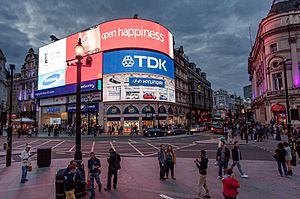
The West End is famous for its theatres. It's a major centre for performing arts. Soho is a hub for media and creative businesses. Oxford Street is a very popular place for shopping.
Famous Landmarks
The City of Westminster has some of London's most famous sights. These include Buckingham Palace, where the King lives. Also, Westminster Abbey and the Palace of Westminster (Houses of Parliament). And of course, Big Ben.
The Centre of London
Charing Cross is considered the very centre of London. It's the point from which distances from London are measured. This tradition started with the Eleanor crosses in the past.
Parks and Green Spaces
Westminster has many beautiful parks. These include Green Park, Hyde Park, Kensington Gardens, Regent's Park, and St James's Park. These parks offer great places to relax and enjoy nature.
Getting Around Westminster
Train Stations
Four main train stations serve the City of Westminster:
These stations connect Westminster to many parts of London and beyond.
London Underground
The City of Westminster has 27 London Underground stations. Ten of the eleven Tube lines pass through the borough. This makes it very easy to travel around.
Electric Car Charging
Westminster City Council has many electric vehicle charging points. These help people charge their electric cars. By 2018, there were 60 charging spots.
How People Travel to Work
In 2011, many residents used public transport for work. About 21% used the Underground. About 9.3% walked or took the bus. Some people also drove, cycled, or worked from home.
Learning and Education

Westminster Children's Services runs many schools. There are primary and secondary schools. Some are faith schools, like Church of England or Roman Catholic. There are also private schools.
Universities and Colleges
Westminster is home to many important universities and colleges:
- The University of Westminster has three campuses here.
- The Strand campus of King's College London.
- The London Business School, in Regent's Park.
- The London School of Economics, near Aldwych.
- The Royal Academy of Music, for music students.
- University of the Arts London has colleges here.
- City of Westminster College is a college for further education.
- Regent's College, located in Regent's Park.
- Westminster Kingsway College has centres in Soho and Victoria.
- The Royal College of Art in Kensington Gore.
Public Libraries
The city has two main reference libraries. These are Westminster Reference Library and Marylebone Information Service. Westminster Reference Library has special collections. These include a Sherlock Holmes collection.
Westminster also has two special libraries:
- The Westminster Music Library, which is the UK's largest music library.
- The Westminster Chinese Library, in the Charing Cross Library.
There are also many free public lending libraries. These include Charing Cross Library, Paddington Library, and Victoria Library.
Embassies and High Commissions
Many countries have their embassies or High Commissions in Westminster. These are like their country's offices in the UK.
Famous People from Westminster
Many famous people have lived in or come from the City of Westminster.
Westminster's Coat of Arms
The current Westminster coat of arms was given in 1964. It has symbols from older areas that joined to form the city. The portcullis (a gate symbol) is a main part of the design.
Freedom of the City
Some special people and military groups have been given the "Freedom of the City" of Westminster. This is a great honour.
Individuals Honoured
- Sir Winston Churchill: 1946.
- Sir Robert Mark: 1977.
- Margaret Thatcher: 1990.
Military Units Honoured
- HMS Westminster, a Royal Navy ship: 2005.
Images for kids
-
Ethnic makeup of the Westminster including the City of London in 2021
See also
 In Spanish: Ciudad de Westminster para niños
In Spanish: Ciudad de Westminster para niños




